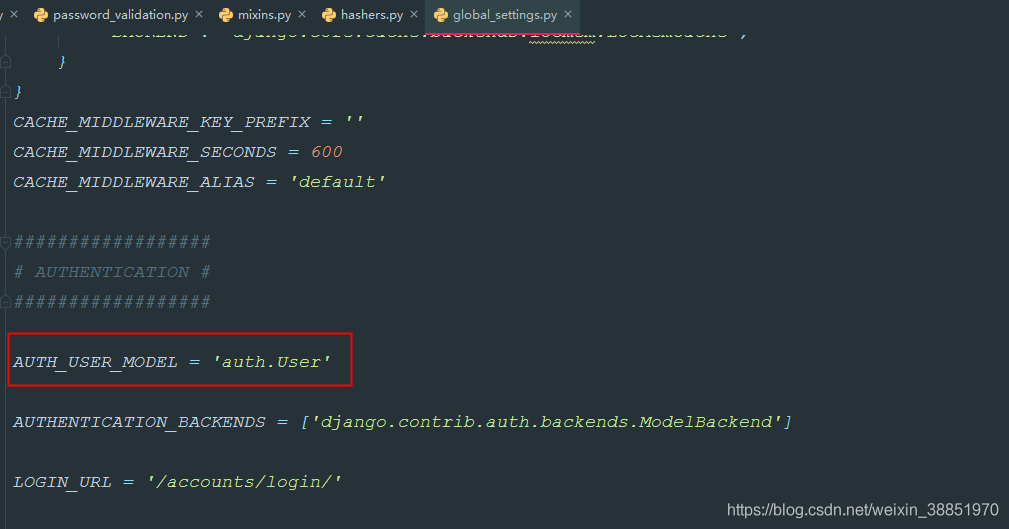使用django自帶的user做外鍵的方法
一、使用django自帶的user做外鍵,可以直接在model中使用。只需導(dǎo)入settings模塊
使用方法:在app應(yīng)用(此處是Product應(yīng)用)中的models.py文件,導(dǎo)入settings模塊
# Product / models.pyfrom django.db import modelsfrom django.contrib.auth import settingsclass Product(models.Model): productName = models.CharField(’產(chǎn)品名稱’, max_length=20) productDescription = models.CharField(’產(chǎn)品描述’, max_length=100) producer = models.ForeignKey(settings.AUTH_USER_MODEL, verbose_name=’負(fù)責(zé)人’, on_delete=models.SET_NULL,blank=True, null=True) createTime = models.DateTimeField(’創(chuàng)建時(shí)間’, auto_now=True) class Meta: verbose_name = ’產(chǎn)品管理’ verbose_name_plural = ’產(chǎn)品管理’ def __str__(self): return self.productName

二、自定義User Model
方法一、擴(kuò)展AbstractUser類:只增加字段
app/models.py
from django.contrib.auth.models import AbstractUserfrom django.db import modelsclass NewUser(AbstractUser):new_field = models.CharField(max_length=100)
同時(shí),需要在global_settings文件中設(shè)置:
AUTH_USER_MODEL = 'app.NewUser'
方法二、擴(kuò)展AbstractBaseUser類AbstractBaseUser中只包含3個(gè)field: password, last_login和is_active. 擴(kuò)展方式同上
# django.contrib.auth.base_userclass AbstractBaseUser(models.Model): password = models.CharField(_(’password’), max_length=128) last_login = models.DateTimeField(_(’last login’), blank=True, null=True) is_active = True REQUIRED_FIELDS = [] # Stores the raw password if set_password() is called so that it can # be passed to password_changed() after the model is saved. _password = None class Meta: abstract = True def __str__(self): return self.get_username() def save(self, *args, **kwargs): super().save(*args, **kwargs) if self._password is not None: password_validation.password_changed(self._password, self) self._password = None def get_username(self): '''Return the username for this User.''' return getattr(self, self.USERNAME_FIELD) def clean(self): setattr(self, self.USERNAME_FIELD, self.normalize_username(self.get_username())) def natural_key(self): return (self.get_username(),) @property def is_anonymous(self): ''' Always return False. This is a way of comparing User objects to anonymous users. ''' return False @property def is_authenticated(self): ''' Always return True. This is a way to tell if the user has been authenticated in templates. ''' return True def set_password(self, raw_password): self.password = make_password(raw_password) self._password = raw_password def check_password(self, raw_password): ''' Return a boolean of whether the raw_password was correct. Handles hashing formats behind the scenes. ''' def setter(raw_password): self.set_password(raw_password) # Password hash upgrades shouldn’t be considered password changes. self._password = None self.save(update_fields=['password']) return check_password(raw_password, self.password, setter) def set_unusable_password(self): # Set a value that will never be a valid hash self.password = make_password(None) def has_usable_password(self): ''' Return False if set_unusable_password() has been called for this user. ''' return is_password_usable(self.password) def get_session_auth_hash(self): ''' Return an HMAC of the password field. ''' key_salt = 'django.contrib.auth.models.AbstractBaseUser.get_session_auth_hash' return salted_hmac(key_salt, self.password).hexdigest() @classmethod def get_email_field_name(cls): try: return cls.EMAIL_FIELD except AttributeError: return ’email’ @classmethod def normalize_username(cls, username): return unicodedata.normalize(’NFKC’, username) if isinstance(username, str) else username
到此這篇關(guān)于使用django自帶的user做外鍵的方法的文章就介紹到這了,更多相關(guān)django user做外鍵內(nèi)容請(qǐng)搜索好吧啦網(wǎng)以前的文章或繼續(xù)瀏覽下面的相關(guān)文章希望大家以后多多支持好吧啦網(wǎng)!
相關(guān)文章:
1. Ajax實(shí)現(xiàn)表格中信息不刷新頁面進(jìn)行更新數(shù)據(jù)2. ajax post下載flask文件流以及中文文件名問題3. CSS自定義滾動(dòng)條樣式案例詳解4. 詳解CSS偽元素的妙用單標(biāo)簽之美5. SpringBoot+Shiro+LayUI權(quán)限管理系統(tǒng)項(xiàng)目源碼6. msxml3.dll 錯(cuò)誤 800c0019 系統(tǒng)錯(cuò)誤:-2146697191解決方法7. 將properties文件的配置設(shè)置為整個(gè)Web應(yīng)用的全局變量實(shí)現(xiàn)方法8. HTML <!DOCTYPE> 標(biāo)簽9. 關(guān)于Mysql-connector-java驅(qū)動(dòng)版本問題總結(jié)10. JavaScrip簡單數(shù)據(jù)類型隱式轉(zhuǎn)換的實(shí)現(xiàn)

 網(wǎng)公網(wǎng)安備
網(wǎng)公網(wǎng)安備